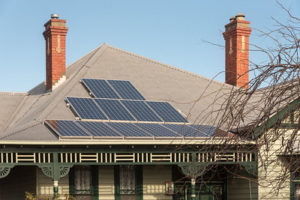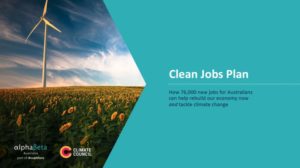With the current economic climate, reduced council rates and the focus on recovering the economy, many councils have seen climate change action and priorities fall to the wayside. While this can be discouraging, there are ample opportunities to bridge the gap between climate projects and economic recovery. In fact, an economic recovery that keeps climate at the forefront not only creates more jobs, but also safeguards our future against the impacts of climate change.
Our June 2020 webinar focused on this very topic: keeping climate action and sustainability projects on the economic recovery agenda. We were joined by Rachel Ollivier, General Manager of Sustainability and Strategy at Darebin City Council, and Krista Milne, Co-director of Climate Change and City Resilience at the City of Melbourne.
They discussed challenges as well as provided insights on how councils can keep climate front of mind during the economic recovery.

A rooftop in Northcote, City of Darebin
At Darebin City Council, Rachel said that local government strengths lie in the ability to focus climate related efforts on specific areas that they know well, like waste management for example. Part of local government’s responsibility is translating the national economic recovery story to a local audience.
“Councils can amplify and normalise a green recovery and that’s really important to remember. It is a bit tricky because Councils have to walk a line with the local community, and the messaging is changing, but Councils can lead in this respect,” said Rachel.
When it comes to community emissions, Darebin is committed to achieving this in the longer term. However Rachel highlighted the importance of policy levers at the state or federal level, something that Lisa Paton from City of Port Phillip also called attention to.
“That’s the big game. And that’s why advocacy to other levels of government is so important. Council doesn’t have the levers to make this shift. If we’re going to shift the community at speed and scale, we need policy change or service redesign to deal with that difficult task,” said Rachel.

Cycling in Fitzroy Gardens
At the City of Melbourne, Survive: Adapt: Thrive, has been the guiding maxim for Council during the pandemic. The city made some decisions early in the pandemic to prioritise sustainable projects to support cycling and greening the city. As Krista put it, “There has been a big uptick in people connecting with nature and being in open spaces.”
It fast tracked a bike lanes strategy, rolling out 40km of bike lanes in two instead of four years. “This was a really nice alignment: through the Climate and Biodiversity Emergency Response Council fast tracked the delivery from 10 to four years, and because of the Covid 19 crisis Council expedited it even faster.”
As part of the City of Melbourne’s Greening the City strategy 150,000 native trees and shrubs will be planted, with a particular emphasis on understorey plants (shrubs and grasses). The ambitious revegetation project will benefit the community, support biodiversity, increase canopy cover and create good, local jobs. So far, 60 planting jobs have been created.
Using Federal Stimulus Package Funds for Climate Initiatives
When the government released their Local Roads and Community Infrastructure Package, there was some uncertainty about what kind of climate-related projects could be submitted, and to what degree council shovel-ready capital upgrade projects could be influenced to be more sustainable.
Both Darebin and City of Melbourne highlighted the need to influence shovel-ready projects planne,, as council already had a list of ready-to-go projects. However, Rachel from Darebin said their discussions regarding what type of projects always used a climate lens and Krista from Melbourne said this was also a focus at Melbourne.
“Our discussion was ‘can we prioritise using a climate lens’. We are updating recreation facilities and we have committed to transition away from polluting gas in these upgrades. We are embedding these sorts of actions into our capital works as much as possible,” said Rachel.
Funding Opportunities
During our last webinar, we also heard from Alexi Lynch (Lex) at Ironbark Sustainability and Rob Law from the Central Victorian Greenhouse Alliance (CVGA) about what types of sustainability projects councils could submit for the Local Roads and Community Infrastructure (LCRI) funds.
Both Lex and Rob highlighted some great examples of projects that aligned with these funding requirements and ways to include sustainability into otherwise standard infrastructure projects. Key examples included extensive LED lighting upgrade projects, EV charging infrastructure and for those trying to get sustainability into otherwise standard infrastructure projects – including recycled content in new roads.
Unfortunately, unless a council has already submitted a project, it is likely too late for a council to get funding for this round. However, as Lex highlighted, it is a prime opportunity to prepare these projects for what will inevitably be another round of federal (or even state) stimulus funding in the year(s) to come.
Click here to check out the webinar recording, here for information about the CVGA EV charging the regions project, and here for information about how to reduce emissions in road construction in this Ironbark Sustainability Report.
________
A strong economy needs a healthy environment. By focusing on clean policy measures, governments (at all levels) can create jobs, build modern, resilient electricity systems, develop new industries, restore and protect Australia’s unique landscapes and safeguard communities from the impacts of climate change.
The Climate Council’s Clean Jobs Plan highlights a dozen policy opportunities for a clean recovery. If you’re interested, please visit the Climate Council’s website to read or watch more. You can also email your state member a copy of the plan.



